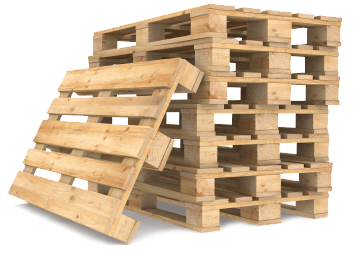Way To Prevent Growth of Mould on Wooden Pallets
25 Apr 2018
Mould can take a variety of forms, and there are some so tiny they cannot be seen without a microscope. Generally mould – or the growth of fungi – is not a good thing when it comes to wood, as it can look unsightly and may even weaken the timber eventually by feeding on and breaking up its internal structure. In a business that uses a lot of wooden pallets, preventing the growth of mould is seen as good practice, as it helps to keep the pallets fresher and in better condition.

Mould Spores Are Everywhere
Spores can irritate those with allergies or asthma, which is another good reason to minimise fungal growth. Some spores like feeding on the sugars or proteins in wood and can make the wood more permeable to water and increase the potential for rot. Some moulds produce toxins too, so from a health perspective mould needs to be controlled, and mouldy pallets can also contaminate goods during shipping.
There are a number of ways of preventing the growth of mould on pallets. The first thing is to eliminate what mould needs to grow. Generally, this includes oxygen, sufficient warmth, a source of energy and moisture. Temperature control and restricting oxygen might be a little complicated when it comes to wooden pallets, but controlling moisture levels can be effective in limiting mould growth. A well-ventilated pallet is less likely to be mouldy. Avoid storing damp pallets in a pile or a stack for lengthy periods.
However, even if pallets are generally kept dry, just a short exposure to moisture can be enough for spores to land on the wood and start germinating, growing and producing more spores. Kiln drying may help, but it can be costly, and the drying must be uniform. If the wood becomes moist again, then mould can take hold. Heat treatment is another way of tackling the issue. With heat treatment, spores on the surface may be eliminated, but the wood will not necessarily be dried completely, and any spores left in damp crevices may actually flourish as competition elsewhere is wiped out. Pallets that have damp patches can easily become mouldy.
Apply the Chemicals
Another way of preventing mould on pallets is to spray them with fungicides. These prophylactic chemicals can be applied to give protection for around three to six months. Fungicides are generally applied after the wood is sawed, either by dipping or spraying, and many are effective against a range of fungi and moulds. Around 20 different chemicals are presently used for giving preventative mould treatment to wood, and the chemicals can be used in combinations that provide insurance against a broad spectrum of moulds.
Not everyone is thrilled with using chemicals for preventing the growth of mould on wood, so alternatives are being developed. These include using essential oils, but they work best in solvents that may lead to an elevated fire risk. Chitosans, derived from chitin in shrimp, have some effect on controlling wood mould, but they have not been widely tested. Non-biocidal protection agents may work by coating the surface of the wood, but more testing is needed. It is a complex issue, but making sure your pallets are dry and well ventilated will definitely help.


